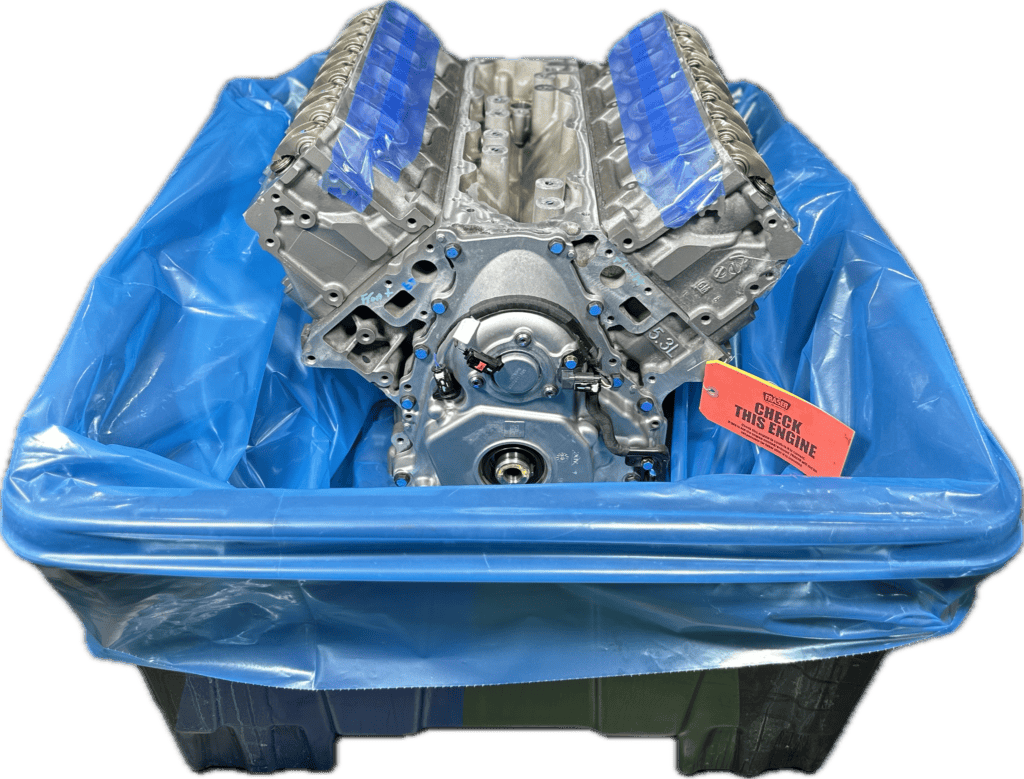STEP 1) ENGINE BLOCK DISASSEMBLY
Our journey begins with a thorough visual inspection of each engine block for casting defects. We meticulously disassemble the components, inspecting each part for damage and identifying the cause of failure. We remove oil and water passage plugs to guarantee optimal results during thermal cleaning. We select only premium castings for our marine blocks, insisting on replacements in all salt-water applications. For high-performance engines, we utilize premium cores, never employing repaired castings or sleeved blocks, preserving the authenticity of your classic car’s original block casting with our skilled technicians’ craftsmanship.
STEP 2) ENGINE BLOCK THERMAL CLEANING
We elevate engine parts to a new level of clean with our thermal cleaning system. This process evenly distributes heat throughout the chamber, avoiding overheating or warping. Components are heated in an oxygen-deficient atmosphere, decomposing combustible hydrocarbons and leaving parts dry. We use the Ace RKE 230 oven exclusively for cast iron blocks, ensuring ash residue is effortlessly removed in the subsequent stainless steel shot blasting phase.
STEP 3) ENGINE BLOCK SHOT BLASTING
Our shot-blasting method employs stainless steel shot to remove surface contamination like rust, creating a smoother finish. This step is vital for detecting surface and subsurface defects during quality inspection. The peening process imparts compression strength to the metal, preparing it for a preliminary defect inspection.
STEP 4) ENGINE BLOCK MAGNAFLUXING
We use magnetic particle inspection to detect cracks and imperfections in ferrous engine parts, ensuring the highest quality for our cast iron blocks. Before proceeding to aluminum blocks, we explain their specific cleaning, testing, and defect checking processes.
STEP 5) ENGINE BLOCK HIGH PRESSURE WASH
Aluminum engine blocks first encounter our AXE SW20 OS spray cleaning system, which removes all foreign material with its powerful spraying action and multi-integrated nozzles. This step is crucial for a thorough inspection.
STEP 6) ENGINE BLOCK SONIC CLEANING
We use ultrasonic cleaning for aluminum blocks, known as the benchmark in cleanliness. This method reaches inaccessible areas, breaking the bonds that hold small particles to surfaces. Post-cleaning, the block undergoes pressure testing.
STEP 7) ENGINE BLOCK PRESSURE TESTING
We employ the Delta Pressure tester to double-check for pinholes after magnafluxing and dye testing, ensuring the integrity of all castings used in our products.
STEP 8) ENGINE BLOCK PREPARATION
After a complete visual inspection, we repair minor casting defects, remove broken bolts, tap threads, and perform gasket surface repairs to minimize stock removal.
STEP 9) ENGINE BLOCK MACHINING
We use the RMC CNC V40 enclosed machining center for precise and versatile machining. This computerized machine measures and levels blocks, measures deck heights & cylinder bore sizes, eliminating operator error. Our machine determines Ra finish based on block type and gasket used, utilizing CBN cutters and checking surface finish with the Mitutoyo SJ-301.
STEP 10) ENGINE BLOCK ROD RECONDITIONING
The Sunnen LBB-1600 Hone, measuring accuracy within .0001″, is our choice for precision rod reconditioning and pin fitting, ensuring honed bores equal to or better than new rods. High-performance engines are fitted with ARP high-strength bolts and nuts prior to this step.
STEP 11) ENGINE BLOCK HONING
We are the first to use Rottler’s newest cylinder honing machine, ensuring the most accurate honing with cylinders finishing within .0001″ roundness and straightness. This machine continuously analyzes and corrects the bore, maintaining evolving engine designs’ critical oil clearances and machining tolerances.
STEP 12) ENGINE BLOCK HIGH PRESSURE WASH
After precise machining, our blocks undergo a second high-pressure wash cycle, ensuring absolute cleanliness for final assembly.
STEP 13) ENGINE BLOCK SONIC CLEANING
We ultrasonically clean all parts prior to assembly, ensuring the ultimate cleanliness level. This method reaches every surface and internal area, providing the cleaning force required for the most stringent standards.
STEP 14) ENGINE BLOCK ASSEMBLY
Each assembler at Fraser Engines conducts a thorough visual inspection and measures parts for proper size. We fit blocks with new cam bearings, oil restrictors, relief valves, new water and oil plugs, and more. Cylinder heads are installed with new bolts and gaskets, and each cylinder’s seal integrity is checked. The final inspection by our assembly manager ensures the highest quality for your remanufactured engine.
Fraser Engines is committed to delivering engines of exceptional quality and performance. Our rigorous, detailed remanufacturing process ensures every engine we deliver meets our high standards and exceeds your expectations.



 Re-machined Engine Block
Re-machined Engine Block